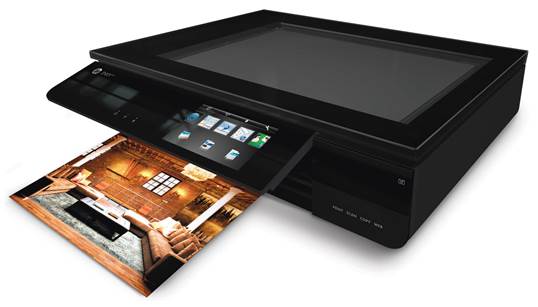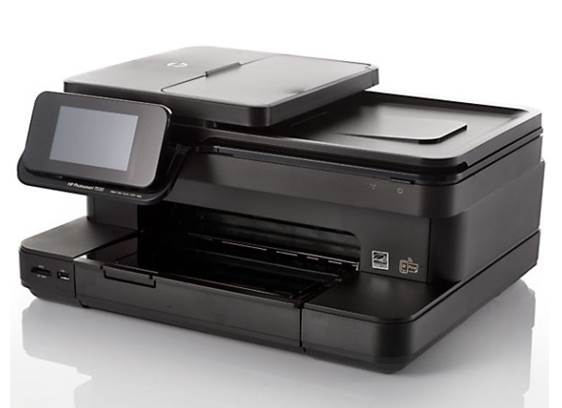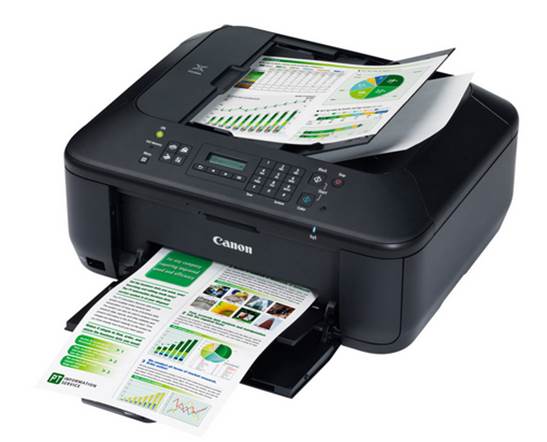HP Envy 120
This sumptuous slab of glass and gloss
black is an unlikely all-in-one printer, and it’s as luxurious as they come.
It’s just 110mm high with a see-through scanning lid, and when you first turn
it on the motorized control panel – complete with color touchscreen rises
gracefully to greet you. If you think that’s neat, wait until you print
something: the thin output tray arm extends automatically too.
Everything is designed for a smooth
experience, and that includes the initial setup. You’re prompted to go online
and create an ePrint account for printing over email, and the wireless security
settings are automatically sent to the device. AirPrint worked flawlessly at
the first time of asking, too.

If
you think that’s neat, wait until you print something: the thin output tray arm
extends automatically too
If it was easy to make a printer so small
and sleek they’d all be doing it, so there are compromises. HP’s quoted print
speeds of 7ppm for mono and 4ppm for color are the lowest here, and we didn’t
get even hit them in our tests. Draft mono pages came out at 5.8ppm, with
normal quality at 3.7ppm. Color pages came out at just 2.8ppm, but a 6 x 4in
photo took a more reasonable 63 seconds.
With only two cartridges, quality was never
going to match that of the six-ink printers here, but our test prints were
still okay. Colors were mostly accurate, although photos had a cold, bluish
tinge to them, and text wasn’t particularly crisp.
Buying Advice
Still, if Apple made a printer, it would
probably be a lot like the Envy 120. It’s beautifully designed and built,
initial setup and daily use are as easy as any we’ve experienced, and it comes
with the highest price tag and running costs here. Whether it’s right for you
depends on your approach to home furnishings: pretty much every printer here is
better for actual printing, but nothing comes close to the Envy 120’s glorious
design.
HP Envy 120 specs
·
Price: $363
·
Ratings: 4/5
·
Pros: Well-built and compact; smooth setup
process
·
Cons: You’re paying for design not print quality
HP Photosmart 7520
The Photosmart 7520 has a very different
design to the others, eschewing the low and flat look for a stepped shape. The
smaller top shelf has the scanner platen, a 25-sheet foldaway ADF and a
protruding tablet-style touchscreen, then there’s a cut-out thin body before
you reach the bulky base, where A4 and photo trays sit.

The
Photosmart 7520 has a very different design to the others, eschewing the low
and flat look for a stepped shape
As with the envy 120, the extensive setup
process takes you online for the latest software, and sets up an ePrint account
for you as well – it also supports AirPrint. The touchscreen is large and
clear, nice and responsive to touch, and has all sorts of basic on-device image
editing tools.
Lifting the lid gives you access to the
print carousel, which takes five individual inks – including a pigment-based
black for better text output, just like the top-end Canon and Epson printers.
As such we expected a lot from our test prints, but performance was a bit
hit-and-miss.
sure, text was sharp and well-formed, and
it came out at a nippy 10ppm at normal quality (and nearly 16ppm in draft
mode), but photos were pale and lacked impact. the detail was good, with no
visible grain, but in blind tests we picked the Epson and Canon photos ahead of
the HP every time.
It’s also a noisy printer that likes to
spend a lot of its time performing maintenance, humming and whirring away even
between print jobs. In an office that’s not an issue, but it’s not ideal
in a quiet home.
Buying Advice
Perhaps we’re being overly harsh – after
all, this is the second-cheapest printer here at just $187. But it’s not that
much better than the Canon Pixma MX455 and not that much cheaper than the
MG6350, which makes it a bit of a compromised middle-ground option.
HP Photosmart 7520 specs
·
Price: $187
·
Ratings: 3/5
·
Pros: Two paper trays and an ADF; big touchscreen;
price
·
Cons: Disappointing photo quality; boxy design;
noisy
Buying Advice
It can be tricky to choose between printers
these days. Features such as AirPrint support have gone from surprise extras to
standard offerings, and with some of the lower-quality manufacturers no longer
making inkjets, it’s actually hard to buy a truly bad printer.
In one sense that means you really don’t
have to spend a lot to get results. The $118 Canon Pixma MX455 is a beast of a
printer that almost needs a desk to itself, but if you have the space it will
produce perfectly good prints with reasonable running costs.

The
$118 Canon Pixma MX455 is a beast of a printer that
almost needs a desk to itself
At the other end of the scale, the HP Envy
120 costs three times as much, and with its glass lid and compact dimensions
it’s a thing of real beauty.
Those are both valid options, but most
people’s budgets and needs lie in the middle. The HP Photosmart 7520 is the
next cheapest; performance is pretty good, particularly with documents, so it
makes a solid choice for a home office. The Brother MFC-J4510DW is also
office-focused, matching the HP’s fax functions and large paper tray. It’s more
compact and stylish, but beyond an Ethernet connection, there’s not much here
to justify the much higher cost.
That leaves the two photo specialists, and
it’s here that the real quality gets shown off. The Epson Expression Photo
XP-750 is the pick for pure photo quality, producing glorious prints on glossy
paper thanks to its six separate inks. If photos are your number one priority,
it’s hard to look elsewhere.
But even the most enthusiastic photographer
prints documents too, and when we look at the whole picture there’s one printer
that rises to the top. The Canon Pixma MG6350 produces superb photos, and
unlike the Epson it backs them up with excellent document quality. It’s sleek
and stylish, its running costs are slightly lower, and it costs less to
buy, which makes it our all-round inkjet pick.